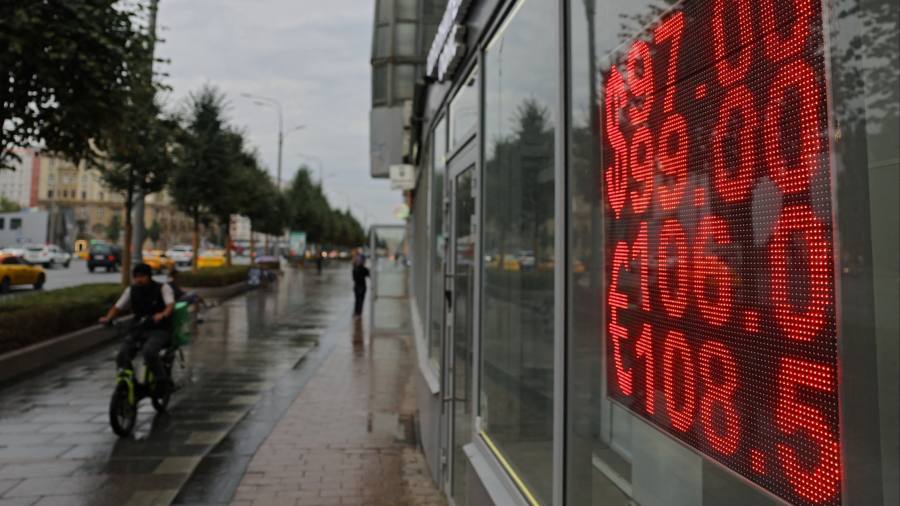Receive free Russian economy updates
We’ll send you a myFT Daily Digest email rounding up the latest Russian economy news every morning.
Russia’s central bank has raised its key interest rate 3.5 percentage points to 12 per cent at an extraordinary meeting, after the rouble fell below Rbs100 to the dollar.
The currency strengthened ahead of and immediately after the large rate rise on Tuesday, which exceeded market expectations, before paring some gains to trade at 98 roubles to the dollar, having weakened past 102 on Monday.
The collapse in the rouble highlights jitters about Russia’s economic prospects almost a year and a half into President Vladimir Putin’s full-scale invasion of Ukraine.
The country’s economic policymakers are struggling to balance the competing demands of growing the economy and steering it through western sanctions while keeping the rouble stable, economists say.
The Kremlin has boasted of a return to growth after Russia plunged into recession last year. But fuelling Russia’s recovery and funding Putin’s war machine has required a borrowing bonanza amid low interest rates that has sped up inflation while weakening the rouble.
The central bank said it had taken the decision to “limit risks to price stability” after some inflation indicators rose to more than 7 per cent. But it added that increased pressure on the rouble in the wake of Russia’s invasion of Ukraine was driving inflation expectations.
“Increased internal demand beyond the possibilities of expanding [monetary] supply strengthens stable inflationary pressure and affects rouble exchange dynamics by raising demand for imports,” the central bank said.
It said that further price growth would create a “significant risk” that Russia would not meet its target of reducing inflation to 4 per cent in 2024, and said the rate rise would help it meet that target.
The central bank, which dropped exchange rate targeting in 2014 and switched to a free float, said a decision on whether to lift interest rates further would be based on inflation data and Russia’s success in adapting to western sanctions, as well as “risks from internal and external conditions.”
It did not, however, announce any further measures to tackle the rouble’s slide, such as a return to capital controls akin to those introduced in the early weeks of the war.
“The decision to raise rates higher than market expectations indicates, in our view, that the tightening cycle will be over quickly,” wrote analysts at Sinara, a Russian investment bank.
“The market has already reacted with a strengthening of the rouble, though more time will be needed to talk about a sustainable stabilisation and appreciation trend,” said Sofya Donets, chief Russia economist at Renaissance Capital, a Moscow investment bank.
“The hike is clearly negative for Russia’s growth story in 2023, but should work well to curb inflation risks.”
Russian policymakers have few instruments available to support the rouble slide after western countries froze about $300bn of the country’s foreign currency reserves last year, leaving the central bank unable to boost the rouble by selling dollars and euros.
Analysts doubt that Tuesday’s decision will be enough to stabilise the currency’s decline, as most see excess liquidity as the main factor driving up imports and, consequently, inflation.
“Measures to lower excess rouble liquidity are also required,” Denis Popov, chief analyst at Promsvyazbank, a Russian state-owned bank, wrote in a note.
Analysts also highlighted the central bank’s decision would not have an immediate impact on the rouble.
“The rate adjustment mechanism will transmit into the exchange rate with a certain lag and may not become a quick solution for stabilising it,” said Natalia Lavrova, chief economist at BCS Global Markets.
Elvira Nabiullina, the central bank governor, who has prioritised economic stability through a hawkish inflation policy during her decade in charge, has come under rare public criticism from statist hardliners in recent weeks as the rouble depreciated.
On Monday, Maxim Oreshkin, Putin’s economic adviser, wrote an article blaming the rouble’s fall on the central bank for easing monetary policy, which he said had created extra debt-fuelled demand that was overheating the economy.
“A strong rouble is in the interests of the Russian economy,” Oreshkin wrote.
Read the full article here



